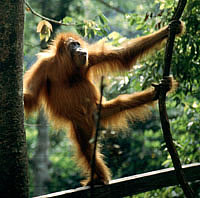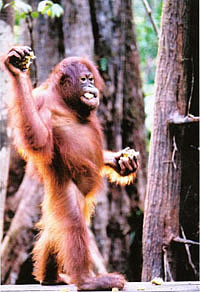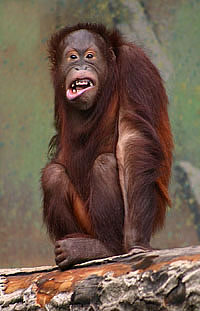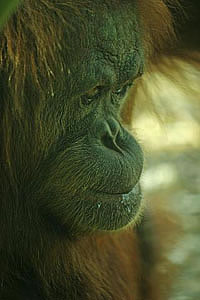



The History of the Orangutan
Read the interesting history of the orangutan.
The orangutans are two species of great apes known for their intelligence, long arms and reddish-brown hair. Native to Indonesia and Malaysia, they are currently found only in rainforests on the islands of Borneo and Sumatra, though fossils have been found in Java, Vietnam and China. They are the only surviving species in the genus Pongo and the subfamily Ponginae (which also includes the extinct genera Gigantopithecus and Sivapithecus). Their name derives from the Malay and Indonesian phrase orang hutan, meaning "man of the forest". The orangutan is an official state animal of Sabah in Malaysia.
The word orangutan (also written orang-utan, orang utan and orangutang) is derived from the Malay and Indonesian words orang meaning "person" and hutan meaning "forest",thus "person of the forest". Orang Hutan is the common term in these two national languages, although local peoples may also refer to them by local languages. Maias and mawas are also used in Malay, but it is unclear if those words refer only to orangutans, or to all apes in general.
The word was first attested in English in 1691 in the form orang-outang, and variants with -ng instead of -n as in the Malay original are found in many languages. This spelling (and pronunciation) has remained in use in English up to the present, but has come to be regarded as incorrect by some.
The name of the genus, Pongo, comes from a 16th century account by Andrew Battell, an English sailor held prisoner by the Portuguese in Angola, which describes two anthropoid "monsters" named Pongo and Engeco. It is now believed that he was describing gorillas, but in the late 18th century it was believed that all great apes were orangutans; hence Lacépède's use of Pongo for the genus.
Orangutans are the most arboreal of the great apes, spending nearly all of their time in the trees. Every night they fashion nests, in which they sleep, from branches and foliage. They are more solitary than the other apes, with males and females generally coming together only to mate. Mothers stay with their babies until the offspring reach an age of six or seven years. There is significant sexual dimorphism between females and males: females can grow to around 4 ft 2 in or 127 centimetres and weigh around 100 lbs or 45 kg, while flanged adult males can reach 5 ft 9 in or 175 centimetres in height and weigh over 260 lbs or 118 kg.
The arms of an orangutan are twice as long as their legs. Much of the arm's length has to do with the length of the radius and the ulna rather than the humerus. Their fingers and toes are curved, allowing them to better grip onto branches. Orangutans have less restriction in the movements of their legs unlike humans and other primates, due to the lack of a hip joint ligament which keeps the femur held into the pelvis. Unlike gorillas and chimpanzees, orangutans are not true knuckle-walkers, and walk on the ground by shuffling on their palms with their fingers curved inwards.
Adult male orangutans exhibit two modes of physical development, flanged and unflanged. Flanged adult males have a variety of secondary sexual characteristics, including cheek pads (called "flanges"), throat pouch, and long fur, that are absent from both adult females and from unflanged males. Flanged males establish and protect territories that do not overlap with other flanged males' territories. Adult females, juveniles, and unflanged males do not have established territories. A flanged male's mating strategy involves establishing and protecting a territory, advertising his presence, and waiting for receptive females to find him. Unflanged males are also able to reproduce; their mating strategy involving finding females in estrus and forcing copulation. Males appear to remain in the unflanged state until they are able to establish and defend a territory, at which point they can make the transition from unflanged to flanged within a few months. The two reproductive strategies, referred to as "call-and-wait" for flanged male and "sneak-and-rape" for the unflanged male, were found to be approximately equally effective in one study group in Sumatra,[10] though this observation did occur during a period of instability in flanged male rank and unflanged male mating success may be lower in Borneo.
Fruit makes up 65% of the orangutan diet. Fruits with sugary or fatty pulp are favored. The fruit of fig trees are also commonly eaten since it is easy to both harvest and digest. Other food items include: young leaves, shoots, seeds and bark. Insects and bird eggs are also included.
Orangutans are thought to be the sole fruit disperser for some plant species including the climber species Strychnos ignatii which contains the toxic alkaloid strychnine. It does not appear to have any effect on orangutans except for excessive saliva production.
Orangutans use plants of the genus Commelina as an anti-inflammatory balm.
Like the other great apes, orangutans are remarkably intelligent. Although tool use among chimpanzees was documented by Jane Goodall in the 1960s, it was not until the mid-1990s that one population of orangutans was found to use feeding tools regularly. A 2003 paper in the journal Science described the evidence for distinct orangutan cultures.
According to recent research by the psychologist Robert Deaner and his colleagues, orangutans are the world's most intelligent animal other than humans, with higher learning and problem solving ability than chimpanzees, which were previously considered to have greater abilities. A study of orangutans by Carel van Schaik, a Dutch primatologist at Duke University, found them capable of tasks well beyond chimpanzees’ abilities — such as using leaves to make rain hats and leakproof roofs over their sleeping nests. He also found that, in some food-rich areas, the creatures had developed a complex culture in which adults would teach youngsters how to make tools and find food.
A two year study of orangutan symbolic capability was conducted from 1973-1975 by Gary L. Shapiro with Aazk, a juvenile female orangutan at the Fresno City Zoo (now Chaffee Zoo) in Fresno, California. The study employed the techniques of David Premack who used plastic tokens to teach the chimpanzee, Sarah, linguistic skills. Shapiro continued to examine the linguistic and learning abilities of ex-captive orangutans in Tanjung Puting National Park, in Indonesian Borneo, between 1978 and 1980. During that time, Shapiro instructed ex-captive orangutans in the acquisition and use of signs following the techniques of R. Allen and Beatrix Gardner who taught the chimpanzee, Washoe, in the late-1960s. In the only signing study ever conducted in a great ape's natural environment, Shapiro home-reared Princess, a juvenile female who learned nearly 40 signs (according to the criteria of sign acquisition used by Francine Patterson with Koko, the gorilla) and trained Rinnie, a free-ranging adult female orangutan who learned nearly 30 signs over a two year period. For his dissertation study, Shapiro examined the factors influencing sign learning by four juvenile orangutans over a 15-month period.
The first orangutan language study program, directed by Dr. Francine Neago, was listed by Encyclopedia Britannica in 1988. The Orangutan language project at the Smithsonian National Zoo in Washington, D.C., uses a computer system originally developed at UCLA by Neago in conjunction with IBM.
Zoo Atlanta has a touch screen computer where their two Sumatran Orangutans play games. Scientists hope that the data they collect from this will help researchers learn about socializing patterns, such as whether they mimic others or learn behavior from trial and error, and hope the data can point to new conservation strategies.
Although orangutans are generally passive, aggression toward other orangutans is very common; they are solitary animals and can be fiercely territorial. Immature males will try to mate with any female, and may succeed in forcibly copulating with her if she is also immature and not strong enough to fend him off. Mature females easily fend off their immature suitors, preferring to mate with a mature male.
Orangutans have even shown laughter-like vocalizations in response to physical contact, such as wrestling, play chasing, or tickling.



